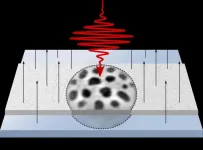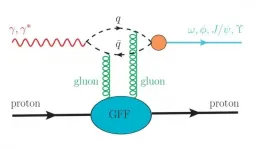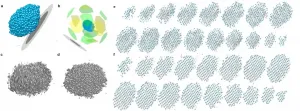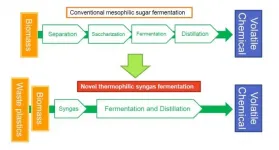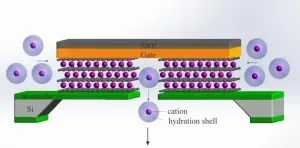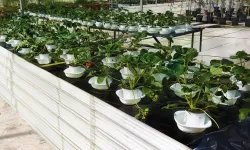How smartphones can help detect ecological change
Plant occurrence data collected with an app uncovers macroecological patterns in Germany
2021-05-12
(Press-News.org) Leipzig/Jena/Ilmenau. Mobile apps like Flora Incognita that allow automated identification of wild plants cannot only identify plant species, but also uncover large scale ecological patterns. These patterns are surprisingly similar to the ones derived from long-term inventory data of the German flora, even though they have been acquired over much shorter time periods and are influenced by user behaviour. This opens up new perspectives for rapid detection of biodiversity changes. These are the key results of a study led by a team of researchers from Central Germany, which has recently been published in Ecography.
With the help of Artificial Intelligence, plant species today can be classified with high accuracy. Smartphone applications leverage this technology to enable users to easily identify plant species in the field, giving laypersons access to biodiversity at their fingertips. Against the backdrop of climate change, habitat loss and land-use change, these applications may serve another use: by gathering information on the locations of identified plant species, valuable datasets are created, potentially providing researchers with information on changing environmental conditions.
But is this information reliable - as reliable as the information provided by data collected over long time periods? A team of researchers from the German Centre for Integrative Biodiversity Research (iDiv), the Remote Sensing Centre for Earth System Research (RSC4Earth) of Leipzig University (UL) and Helmholtz Centre for Environmental Research (UFZ), the Max Planck Institute for Biogeochemistry (MPI-BGC) and Technical University Ilmenau wanted to find an answer to this question. The researchers analysed data collected with the mobile app Flora Incognita between 2018 and 2019 in Germany and compared it to the FlorKart database of the German Federal Agency for Nature Conservation (BfN). This database contains long-term inventory data collected by over 5,000 floristic experts over a period of more than 70 years.
Mobile app uncovers macroecological patterns in Germany
The researchers report that the Flora Incognita data, collected over only two years, allowed them to uncover macroecological patterns in Germany similar to those derived from long-term inventory data of German flora. The data was therefore also a reflection of the effects of several environmental drivers on the distribution of different plant species.
However, directly comparing the two datasets revealed major differences between the Flora Incognita data and the long-term inventory data in regions with a low human population density. "Of course, how much data is collected in a region strongly depends on the number of smartphone users in that region," said last author Dr. Jana Wäldchen from MPI-BGC, one of the developers of the mobile app. Deviations in the data were therefore more pronounces in rural areas, except for well-known tourist destinations such as the Zugspitze, Germany's highest mountain, or Amrum, an island on the North Sea coast.
User behaviour also influences which plant species are recorded by the mobile app. "The plant observations carried out with the app reflect what users see and what they are interested in," said Jana Wäldchen. Common and conspicuous species were recorded more often than rare and inconspicuous species. Nonetheless, the large quantity of plant observations still allows a reconstruction of familiar biogeographical patterns. For their study, the researchers had access to more than 900,000 data entries created within the first two years after the app had been launched.
Automated species recognition bears great potential
The study shows the potential of this kind of data collection for biodiversity and environmental research, which could soon be integrated in strategies for long-term inventories. "We are convinced that automated species recognition bears much greater potential than previously thought and that it can contribute to a rapid detection of biodiversity changes," said first author Miguel Mahecha, professor at UL and iDiv Member. In the future, a growing number of users of apps like Flora Incognita could help detect and analyse ecosystem changes worldwide in real time.
The Flora Incognita mobile app was developed jointly by the research groups of Dr. Jana Wäldchen at MPI-BGC and the group of Professor Patrick Mäder at TU Ilmenau. It is the first plant identification app in Germany using deep neural networks (deep learning) in this context. Fed by thousands of plant images, that have been identified by experts, it can already identify over 4,800 plant species.
"When we developed Flora Incognita, we realized there was a huge potential and growing interest in improved technologies for the detection of biodiversity data. As computer scientists we are happy to see how our technologies make an important contribution to biodiversity research," said co-author Patrick Mäder, professor at TU Ilmenau.
INFORMATION:
ELSE PRESS RELEASES FROM THIS DATE:
2021-05-12
The gopher tortoise (Gopherus polyphemus) is declining because of habitat loss and fragmentation, human interaction including collisions with vehicles, predation by domestic animals, and disease. These long-lived reptiles are found throughout Florida and are affected by various diseases including upper respiratory tract disease. A number of pathogens such as Mycoplasma spp., Herpesvirus, and Ranavirus are known to cause upper respiratory tract disease in gopher tortoises. Chronic disease resulting from these pathogens can lead to reduced reproduction, abnormal growth and development, increased susceptibility to secondary ...
2021-05-12
Lysophospholipids are phospholipids that have just one fatty acid chain, and in recent years, the role of lysophospholipids in physiology and pathophysiology has attracted attention. Lysophosphatidylethanolamine (LPE) is a type of lysophospholipid that are reportedly present in the brain that consist of many species with different fatty acid chain lengths and degrees of unsaturation. The latest studies in animal models have reported elevated levels of LPE in the brain after traumatic brain injury and cerebral ischemia. Fluctuations in LPE concentration have also been reported in the plasma of patients with major depression and Alzheimer's disease. Although these reports suggest the involvement of LPE in brain function, the role of LPE in the brain has remained unclear.
Therefore, ...
2021-05-12
Smaller, faster, more energy-efficient: future requirements to computing and data storage are hard to fulfill and alternative concepts are continuously explored. Small magnetic textures, so-called skyrmions, may become an ingredient in novel memory and logic devices. In order to be considered for technological application, however, fast and energy-efficient control of these nanometer-sized skyrmions is required.
Magnetic skyrmions are particle-like magnetization patches that form as very small swirls in an otherwise uniformly magnetized material. In particular ferromagnetic thin films, skyrmions are stable at room temperature, with diameters down to the ten-nanometer range. It is known that skyrmions can be created and moved by short pulses of electric current. Only recently it was discovered ...
2021-05-12
Researchers have recently extracted the proton mass radius from the experimental data.
A research group at the Institute of Modern Physics (IMP) of the Chinese Academy of Sciences (CAS) presented an analysis of the proton mass radius in Physical Review D on May 11. The proton mass radius is determined to be 0.67 ± 0.03 femtometers, which is obviously smaller than the charge radius of the proton.
In the Standard Model, the proton is a composite particle made of quarks and gluons and it has a non-zero size. The radius of the proton is a global and fundamental property of the proton. It is related to the color confinement radius -- a property governed by quantum chromodynamics (QCD).
The radius of the proton is approximately 100,000 times smaller ...
2021-05-12
Atoms are the basic building blocks for all materials. To tailor functional properties, it is essential to accurately determine their atomic structures. KAIST researchers observed the 3D atomic structure of a nanoparticle at the atom level via neural network-assisted atomic electron tomography.
Using a platinum nanoparticle as a model system, a research team led by Professor Yongsoo Yang demonstrated that an atomicity-based deep learning approach can reliably identify the 3D surface atomic structure with a precision of 15 picometers (only about 1/3 of a hydrogen atom's radius). The atomic displacement, strain, and facet analysis revealed that the surface atomic structure and strain are ...
2021-05-12
The study conducted by the University of Turku and the Finnish Institute for Health and Welfare together with an international research team is so far the largest population-level study in the world examining the connection between human gut microbiota and health and mortality in the following decades.
The composition of the research subjects' gut microbiota was analysed from stool samples collected in 2002. The researchers had access to follow-up data on the subjects' mortality until 2017, i.e., close to the present day.
"Many bacterial strains that are known ...
2021-05-12
Acetone, a volatile solvent used for everything from removing nail polish and cleaning textiles to manufacturing plastics, could get a sustainability boost from a new strain of bacteria engineered by a research team based in Japan.
They published the details of the heat-loving, acetone-producing bacteria called Moorella thermoacetica on April 23 in AMB Express.
Acetone is typically produced through the widely used cumene method, which is cost-effective but not sustainable. The process, developed in 1942, involves converting two non-renewable resources into acetone and phenol, another chemical ...
2021-05-12
The human brain is a vast network of billions of biological cells called Neurons which fires electrical signals that process information, resulting in our sense and thoughts. The ion channels of atomic scale in each neuron cell membrane plays a key role in such firings that opens and closes the ion flow in an individual cell by the electrical voltage applied across the cell membrane, acting as a "biological transistor" similar to electronic transistors in computers. For decades, scientists have learned that biological ion channels are life's transistors capable to gate extremely fast and precisely selective permeation of ions through the atomic-scale selectivity filters to maintain vital living functions. However, ...
2021-05-12
Researchers from the £12 million Developing Human Connectome Project have used the dramatic advances in medical imaging the project has provided to visualise and study white matter pathways, the wiring that connects developing brain networks, in the human brain as it develops in the womb.
Published today in Proceedings of the National Academy of Sciences of The United States of America, the study used magnetic resonance images (MRI) with unprecedented resolution from more than 120 healthy fetuses across the second and third trimesters of pregnancy to define how the structural connections in their ...
2021-05-12
Strawberry production is one of the driving forces in the Spanish agriculture sector, as strawberries are highly valued for their organoleptic characteristics and health benefits. These two factors, their economic relevance, and the value that consumers assign them, make this fruit an object of scientific research from multiple perspectives, including that of food safety. A research project headed by Liliana Pérez-Lavalle, Elena Carrasco, Pedro Vallesquino-Laguna, Manuel Cejudo, Guiomar Denisse Posada and Antonio Valero has aimed to evaluate whether the Salmonella Thompson bacteria, one of the pathogens that can contaminate the fruit through sewage and/or the soil, could penetrate through the roots ...
LAST 30 PRESS RELEASES:
[Press-News.org] How smartphones can help detect ecological change
Plant occurrence data collected with an app uncovers macroecological patterns in Germany


